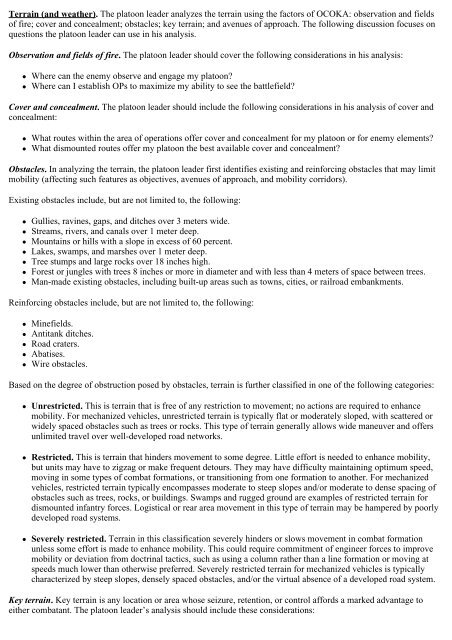FM 17-98 SCOUT PLATOON
FM 17-98 SCOUT PLATOON
FM 17-98 SCOUT PLATOON
Create successful ePaper yourself
Turn your PDF publications into a flip-book with our unique Google optimized e-Paper software.
Terrain (and weather). The platoon leader analyzes the terrain using the factors of OCOKA: observation and fields<br />
of fire; cover and concealment; obstacles; key terrain; and avenues of approach. The following discussion focuses on<br />
questions the platoon leader can use in his analysis.<br />
Observation and fields of fire. The platoon leader should cover the following considerations in his analysis:<br />
• Where can the enemy observe and engage my platoon<br />
• Where can I establish OPs to maximize my ability to see the battlefield<br />
Cover and concealment. The platoon leader should include the following considerations in his analysis of cover and<br />
concealment:<br />
• What routes within the area of operations offer cover and concealment for my platoon or for enemy elements<br />
• What dismounted routes offer my platoon the best available cover and concealment<br />
Obstacles. In analyzing the terrain, the platoon leader first identifies existing and reinforcing obstacles that may limit<br />
mobility (affecting such features as objectives, avenues of approach, and mobility corridors).<br />
Existing obstacles include, but are not limited to, the following:<br />
• Gullies, ravines, gaps, and ditches over 3 meters wide.<br />
• Streams, rivers, and canals over 1 meter deep.<br />
• Mountains or hills with a slope in excess of 60 percent.<br />
• Lakes, swamps, and marshes over 1 meter deep.<br />
• Tree stumps and large rocks over 18 inches high.<br />
• Forest or jungles with trees 8 inches or more in diameter and with less than 4 meters of space between trees.<br />
• Man-made existing obstacles, including built-up areas such as towns, cities, or railroad embankments.<br />
Reinforcing obstacles include, but are not limited to, the following:<br />
• Minefields.<br />
• Antitank ditches.<br />
• Road craters.<br />
• Abatises.<br />
• Wire obstacles.<br />
Based on the degree of obstruction posed by obstacles, terrain is further classified in one of the following categories:<br />
• Unrestricted. This is terrain that is free of any restriction to movement; no actions are required to enhance<br />
mobility. For mechanized vehicles, unrestricted terrain is typically flat or moderately sloped, with scattered or<br />
widely spaced obstacles such as trees or rocks. This type of terrain generally allows wide maneuver and offers<br />
unlimited travel over well-developed road networks.<br />
• Restricted. This is terrain that hinders movement to some degree. Little effort is needed to enhance mobility,<br />
but units may have to zigzag or make frequent detours. They may have difficulty maintaining optimum speed,<br />
moving in some types of combat formations, or transitioning from one formation to another. For mechanized<br />
vehicles, restricted terrain typically encompasses moderate to steep slopes and/or moderate to dense spacing of<br />
obstacles such as trees, rocks, or buildings. Swamps and rugged ground are examples of restricted terrain for<br />
dismounted infantry forces. Logistical or rear area movement in this type of terrain may be hampered by poorly<br />
developed road systems.<br />
• Severely restricted. Terrain in this classification severely hinders or slows movement in combat formation<br />
unless some effort is made to enhance mobility. This could require commitment of engineer forces to improve<br />
mobility or deviation from doctrinal tactics, such as using a column rather than a line formation or moving at<br />
speeds much lower than otherwise preferred. Severely restricted terrain for mechanized vehicles is typically<br />
characterized by steep slopes, densely spaced obstacles, and/or the virtual absence of a developed road system.<br />
Key terrain. Key terrain is any location or area whose seizure, retention, or control affords a marked advantage to<br />
either combatant. The platoon leader’s analysis should include these considerations:











